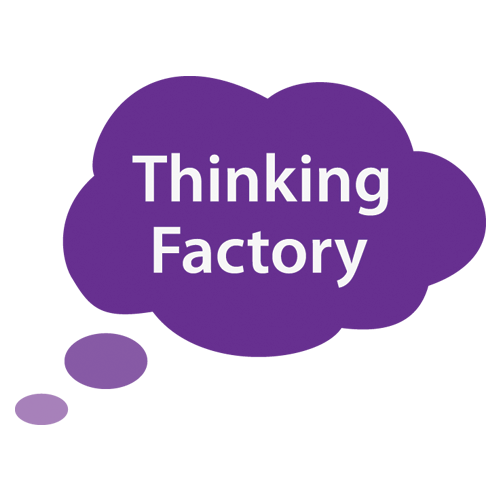Have a look at the three sets of text, A, B and C, below. What similarities do you notice among them?
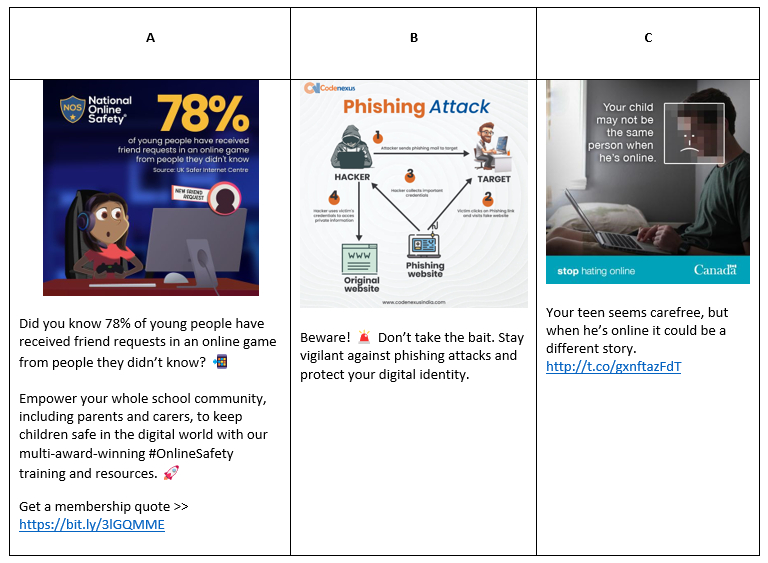
Sources: National Online Safety, Code Nexus, Get Cyber Safe
Here are some similarities you might have observed:
- They speak of the dangers in the online sphere.
- They all contain an image with a short piece of text (caption).
- Two of them have links directing readers to more information.
You might have also guessed that these are found online, and rightly so — these are on social media platforms like Facebook, Instagram and X (formerly Twitter). Such forms of texts are getting very common, in this age where people are scrolling on their mobile phones and attention spans are short. Being able to interpret such short-form texts amidst the information overload, especially on social media, becomes very important.
That is why in the revised O-Level English Language Syllabus (1184), a second, short-form text will be introduced alongside the traditional poster or advertisement. What else is going to be different in this Visual Text component of the revised syllabus? This post will highlight some of the key changes.
1. What are the changes Changes in Paper 2 Visual Text component?
1.1 Two texts instead of one
One of them will include visuals. Both may share a common theme, like environmental conservation, online safety or mental well-being
(see Visuals D and E below).
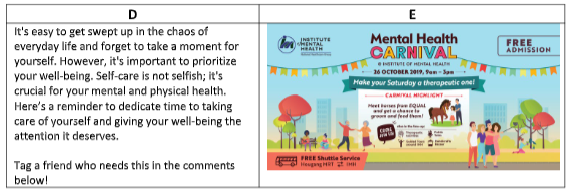
Sources: Calm Collective Asia Facebook, Mental Health Carnival 2019
1.2 One text likely a social media post
As mentioned, short-form texts are all the rage now, with the likes of Instagram, Facebook, X and TikTok (though video texts will not be used in the written paper). Captions from these types of post could be used as 1 of the texts (see Visual D above), alongside the existing types of texts like posters or advertisements (see Visual E above).
1.3 Comparisons between both texts
This could be in terms of PAC (purpose, audience, context), tone and language use.
2. What remains the same?
- Advertisements and posters will continue to be used as one of the texts.
- Questions will continue to test
- comprehension (e.g. What is the message of the advertisement?)
- the use of visuals (e.g. How does the hand holding the globe support the message?)
- the use of language for effect (e.g. Identify the sentence that is meant to persuade readers to participate in the event.)
*Find out more in this post on how to tackle the (existing) Visual Text component.
Source: Revised English Language Syllabus 1184
3. How to tackle the Paper 2 Visual Text component?
Let’s analyse an example
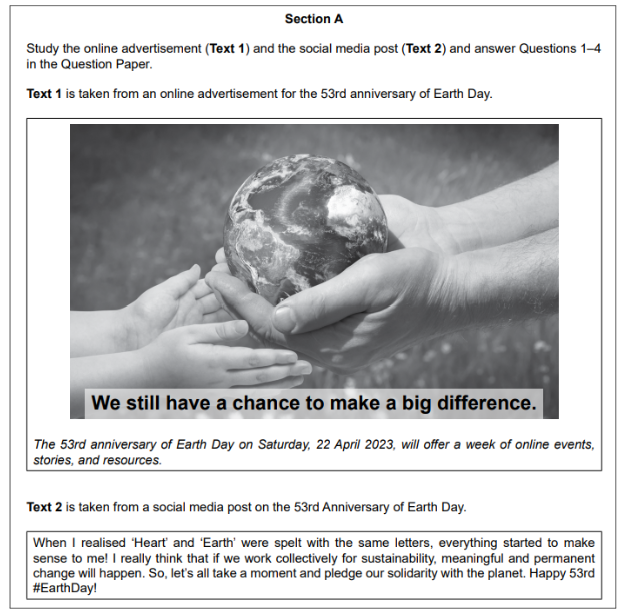
Source: GCE O-Level 1184 English Language Specimen Insert 2 For Examination From 2023
It may be tempting to dive into the questions right away, but let’s take a step back and do a quick analysis of the two texts. Here are some handles to help you:
3.1 Content – Theme and PAC
| Text 1 (with visual) | Text 2 | |
| Theme | Earth Day (supported by picture of globe) | Earth Day |
| Purpose | Appeal to make a big difference on Earth Day (“We still have a chance to make a big difference.”) | Encouragement to protect the earth (“pledge our solidarity with the planet”) |
| Audience | Online users, older generation (hands of adult passing globe to hands of a child) | Social media users |
| Context | Online advertisement | Social media post (stated, use of hashtag #EarthDay) |
3.2 Language use
You can ask yourself questions like these:
- Is there any word or phrase that stands out or is surprising?
- How does the text ‘sound’? (i.e. tone)
For example, in Text 1, the use of the word ‘still’ makes it seem like this call to “make a big difference” is not new; it could be a repeated call to take action on something urgent.
In Text 2, there is a sense of enthusiasm and excitement from the use of exclamation marks (not used in Text 1). It comes across as more personal and candid, from the use of personal pronouns like “I” and phrases like “When I realised…” and “I really think that…”.
These questions are especially helpful if you are in Secondary 1. No doubt you have been exposed to graphic stimulus in primary school, but the additional text and the comparisons you need to make might make things a little trickier. Use these two handles to think through the texts for a start, and
hopefully you’ll find it easier to identify key features of the texts!
3.3 Paper 2 Visual Text component questions
Have a go at the questions. These questions have been taken from the specimen paper of the revised syllabus. They’re meant to give you a taster of what you will be tested. Give them a try, before reading on for the answers and explanations.
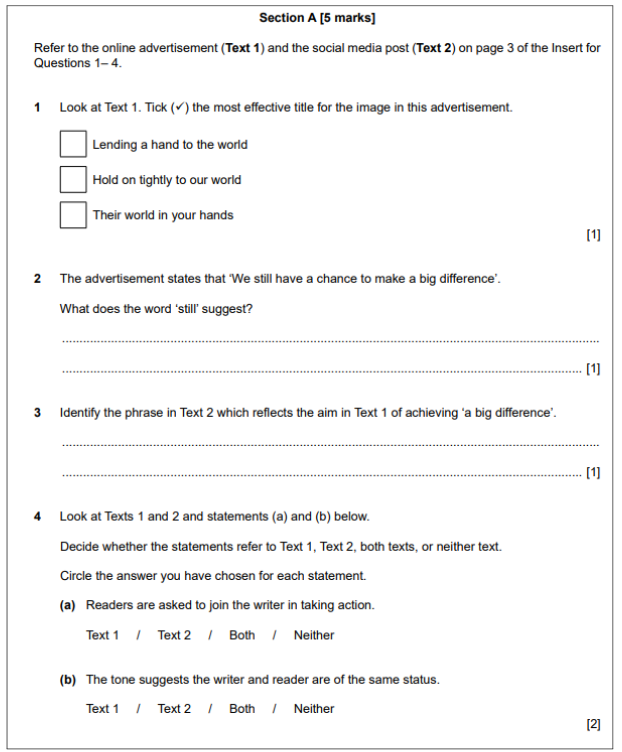
Source: GCE O-Level 1184 English Language Specimen Insert 2 For Examination From 2023
3.4 Suggested answers and explanations
Question 1
Question Analysis:
The question asks for the “most effective” title, which means the title that best captures the key features of the advertisement.
Explanation:
The first option “Lending a hand to the world” may seem plausible with the involvement of two pairs of hands, but on closer inspection, the two pairs of hands are different – one pair belonging to an adult holding the globe, and the other of a child receiving the globe (as noted in our analysis of the target audience above). The third option “Their world is your hands” thus seems like a more appropriate title since it captures the idea of the older generation (“your”) safeguarding the world that they will pass on to the younger generation (“their”). The second option “Hold on tightly” clearly does not make
sense as it shows one pair of hands passing the globe to another.
Correct answer
“Their world in your hands”
Question 2
Question Analysis:
The question asks what the word ‘still’ implies (which we picked up in the “Language use” analysis above).
You can compare the difference between saying “We have achance…” and “We still have a chance…”.
Explanation:
Adding “still” suggests that this chance has been available but may not in the near future, conveying a sense of urgency.
Suggested answer
The word “still” suggests that it is not too late to seize the chance to make a big difference, i.e. protect the Earth.
Question 3
Question Analysis:
This question requires you to compare both texts, specifically in how the idea of ‘a big difference’ in Text 1 is echoed in Text 2.
Explanation:
Look for synonyms or synonymous phrases in Text 2. They should also be in the same word form as the quote, i.e. adjective (‘big’) + noun (‘difference’)
Correct answer
‘permanent change’
Question 4
Question Analysis:
This question also requires you to compare both texts.
(a) asks if the writer has used a ‘call to action’ – language that invites or impels readers to do something in response to the advertisement / post.
(b) asks about the tone, specifically whether the writer regards the reader as an equal (“of the same status”).
Recall what you know about informal and formal language.
Explanation:
This question also requires you to compare both texts.
(a) In Text 1, the statement “We still have a chance to make a big difference.” may not be a direct call to action as in “Make a difference now.”, but it does convey to readers their desired action – seize the chance to make the world a better place. In Text 2, there is a clear call to action with the imperative (command) to “let’s all take a moment and pledge our solidarity…”.
(b) Text 1 does sound more formal than Text 2, as Text 2 uses more personal and spontaneous language like “When I realised” and “I really think that”, a well as exclamation marks and a hashtag (see “language use” analysis above). But don’t be too quick to equate formal language with the writer not treating the reader as of the same status. The use of “We” in the tagline does imply that the writer too has a stake in making the difference.
Correct answers
(a) Both (b) Both
How did you find the questions? Were you able to use some of the strategies mentioned above to think through the questions? If not, I hope that the Question Analysis and Explanation portions of the Suggested answers helped to guide you. It may seem tedious at the start to go through these
thinking processes, but these should gradually become second nature as you exercise your visual literacy muscles more!
